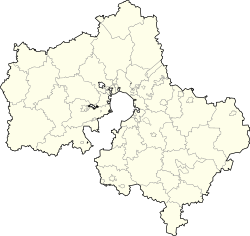Istra High Voltage Research Center
| High Voltage Research Center | |
|---|---|
| Near Istra, Istrinsky District, Moscow Oblast in Russia | |
| Coordinates | 55°55′26.15″N 36°49′10.97″E / 55.9239306°N 36.8197139°E |
| Type | Energy weapon testing, mixed use |
| Site information | |
| Operator | Soviet Union, Russia |
| Status | Mostly inactive |
| Site history | |
| In use | 1970s – present (since 1991 only in intermittent use) |
The High Voltage Research Center (HVRC) (Russian: Высоковольтный научно-исследовательский центр), also called the Tesla Generators Research Facility, is a testing facility built in the 1970s outside the town of Istra, 40 km (25 mi) west of Moscow, operated by the Moscow Power Engineering Institute.
Description
[edit]The facility is notable for containing what is believed to be the world's largest Marx generator, which was originally created to help test lightning insulation in military aircraft. The facility has several huge Tesla coils on the facility grounds, some of which range over 20 stories in height. Combined these create what the Soviets nicknamed a "lightning machine."[1]
In all the facility contains a 3 megawatt capacity transformer cascade, a 9 megawatt Pulsed Voltage Generator (PVG), measuring 39.3 meters high and capable of creating 150-meter artificial lightning, and a 2.25 megawatt constant voltage unit.[1]
History
[edit]Originally built sometime in the 1970s, the facility was at first used for a mix of military and scientific testing being maintained by the Moscow Power Engineering Institute.
After the fall of the Soviet Union the facility became mostly inactive, only being used on occasion for private-sector testing, including testing of the lightning strike resistance of the Sukhoi Superjet 100 in 2011.[2]
The Marx generator is rarely turned on today, with the last recorded use being in August 2014.[3]
Dome
[edit]Construction of a large ovoidal dome, officially named the "High-voltage test bench of the enterprise R-6511" (Russian: "Высоковольтный испытательный стенд предприятия Р-6511"), but also known as the "Istra dome", began in 1982. The building was to be used as an electromagnetic pulse (EMP) weapons testing facility, with commissioning planned for the fourth quarter of 1985, but construction was never completed: the dome collapsed in the morning of 25 January 1985, and was later demolished.[4][5]
This resulted in I. N. Dmitriev, head of the Construction Department of the CPSU Central Committee, being removed from his post and replaced by Boris Yeltsin in April 1985. Yeltsin would later would serve as the first President of the Russian Federation.
After the dome's collapse, thousands of tons of reinforced concrete were removed from the site.
Later a facility called the "Stationary electromagnetic pulse simulator 'Allure'" (Russian: "Стационарный имитатор электромагнитного импульса 'Аллюр'"), or simply "Allure", was built on the former site of the dome. "Allure" was used for testing the resistance of equipment to the effects of natural and man-made EMPs.[4]
See also
[edit]References
[edit]- ^ a b "The Soviet Lightning Machine Abandoned in a Russian Forest". Atlas Obscura. 2014-07-10. Retrieved 2017-05-12.
- ^ "DailyTech - Pictured: Drone Survives Flyover of Russia's Largest Artificial Lightning Generator". www.dailytech.com. Archived from the original on 2017-05-05. Retrieved 2017-05-12.
- ^ "Abandoned Marx Generator". Atlas Obscura. Retrieved 2017-05-12.
- ^ a b "Величайший "Купол" науки из Истры / Хабр". Хабр (in Russian). 2017-03-10. Retrieved 2023-09-14.
- ^ "Instalaciones de investigación de alta tensión de la URSS: El sueño húmedo de Tesla". Rusadas (in Spanish). Retrieved 2023-09-14.
Text is available under the CC BY-SA 4.0 license; additional terms may apply.
Images, videos and audio are available under their respective licenses.


